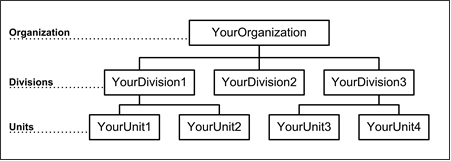Organizational hierarchy
Pega 8 applications group organizational data hierarchically, using nested levels of organizations, divisions, and units. This basic organization hierarchy diagram depicts a sample organizational hierarchy with one organization, three divisions, and four units.

You can use this model as a guide when creating a similar hierarchy to reflect your organization’s functional and reporting structure:
- Highest Level: Organization — identifies the company entity.
- Second Level: Division — identifies the major entities of the company. For example, you might use the structure of your company’s senior management team as a starting place for division-level entities.
- Lowest Level: Unit — identifies the most specific level at which organization information is recorded (for example, a cost center).
As you are deploying your system, identify the business areas with primary users or interested work parties. You can add to or modify the structure at any time as your organization grows and changes. You can display a graphic showing your organization, by selecting the Administrator bar from the Navigation panel, and then selecting Organization Chart from the Organization section.
When users log in with an operator ID, the Pega 8 application they log into and their organizational affiliations grant them appropriate ruleset access. The ID also identifies two additional affiliations: work groups and access groups.
- Work Groups — users and the work they do are tied to work groups, which fall below units in an extended organizational hierarchy. Users working on a common set of items generally belong to a single work group.
- Access groups — users’ application permissions, Ruleset access, portal layout, and accessible work are controlled by access groups. Access groups may span multiple work groups, and typically mirror Pega 8 job functions.
The following diagram shows a part of the SampleCo hierarchy. The North America and Asia divisions each have Marketing and Sales units; each Marketing unit, in turn, has Marketing Communications and Product Management work groups. All work group managers are afforded additional privileges by belonging to the Managers access group.
Previous topic Ruleset overview Next topic Work object model
